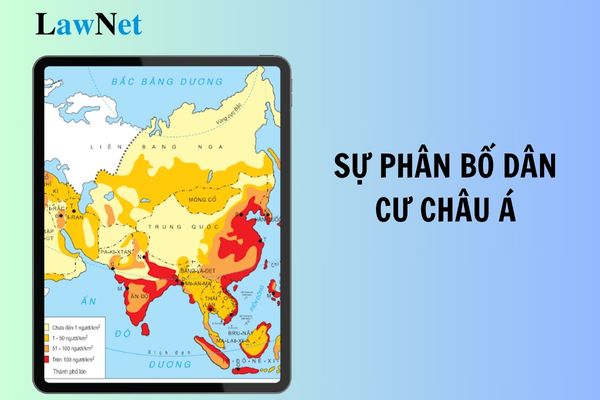What are the guidelines for the presentation of population distribution in Asia for 7th-grade students in Vietnam? Are 7th-grade History and Geography assessed via feedback or scores?
What are the guidelines for the presentation of population distribution in Asia for 7th-grade students in Vietnam?
In the History and Geography course for 7th grade, students need to present the population distribution in Asia.
Below is a reference answer for the population distribution in Asia:
| Asia is the continent with the highest population density in the world, averaging about 150 people/km². However, the population here is not evenly distributed. Most of the population is concentrated in large plains, coastal areas, and regions with favorable natural conditions for agriculture, commerce, and transportation. In contrast, areas with rugged terrain such as high mountains, dry deserts, or regions with harsh climates are usually sparsely populated or nearly uninhabited. |
Detailed presentation of population distribution in Asia:
1. Densely populated areas in Asia:
- Plains and coastal areas:
+ Large plains such as the Yellow River plain, Yangtze River plain in China, Ganges plain in India, and coastal areas of Southeast Asia (such as the Red River Delta, Mekong Delta in Vietnam) have very high population densities.
+ Reason: Plains have fertile soil, abundant water sources, and a favorable climate for agriculture and livelihood.
- Urban areas:
Major cities such as Tokyo (Japan), Shanghai (China), Mumbai (India), and Jakarta (Indonesia) attract millions of people due to job opportunities and public amenities.
2. Sparsely populated areas in Asia:
- High mountain regions: The Himalayas, Tibet, and Pamir have rugged terrain, cold climate, and lack of oxygen, leading to very few inhabitants.
- Desert areas: Large deserts like the Gobi Desert (China, Mongolia), Thar Desert (India, Pakistan) are nearly uninhabitable and lack water sources.
- Cold climate regions: Siberia (in Russia) with its harsh winters, low temperatures, and permafrost is also very sparsely populated.
3. Causes of uneven population distribution:
- Natural causes:
+ Terrain: Plains and low valleys are more accessible than high mountains or desert areas.
+ Climate: Regions with temperate, warm climates generally attract more population than extreme cold or hot climates.
+ Resources: Areas with fertile land, fresh water, and abundant mineral resources often draw dense populations.
- Economic-social: Economic opportunities and the development of industries, and services in major urban centers are crucial factors. In contrast, rural, underdeveloped, or remote areas struggle to attract people.
- Historical: Areas with a long history of culture and agriculture (such as China, India) have developed densely populated regions early on.

What are the guidelines for the presentation of population distribution in Asia for 7th-grade students in Vietnam? Are 7th-grade History and Geography assessed via feedback or scores? (Image from Internet)
Are 7th-grade History and Geography assessed via feedback or scores?
According to Clause 3 Article 5 Circular 22/2021/TT-BGDDT:
Form of assessment
...
3. Assessment methods for subjects
a) Conduct assessment for: Physical education (PE), Art, Music, Fine Arts, local education subjects, experience learning activities, and career counseling; learning results of subjects shall be categorized as “Đạt” (Qualified) or “Chưa đạt” (Unqualified).
b) Conduct assessment based on both feedback and scores for subjects in formal education program, except for those under Point a of this Clause; subject-based learning results shall be given in a total of 10 scores, any other form of scores must be converted to 10-score model. Assessment score must be an integer or a decimal number rounded to the nearest tenths.
Thus, 7th-grade History and Geography are assessed based on both feedback and scores.
What are the assessment levels for learning results of 7th-grade students in each semester in Vietnam?
According to Clause 2 Article 9 Circular 22/2021/TT-BGDDT, the learning results of a student in each semester shall be assessed by one of 4 categories: Excellent, Good, Qualified, Unqualified.
1) Excellent:
- All subjects assessed with feedback are placed in Qualified category.
- All subjects assessed by both feedback and scores have minimum scores of 6.5 for DTBmhk and DTBmcn with 6 subjects among which have minimum scores of 8.0 for DTBmhk and DTBmcn.
2) Good:
- All subjects assessed with feedback are placed in Qualified category.
- All subjects assessed by both feedback and scores have minimum scores of 5.0 for DTBmhk and DTBmcn with 6 subjects among which have minimum scores of 6.5 for DTBmhk and DTBmcn.
3) Qualified:
- Have no more than 1 subject assessed via feedback placed in Unqualified category.
- At least 6 subjects assessed by both feedback and scores have minimum scores of 5.0 for DTBmhk and DTBmcn with 0 subjects have scores lower than 3.4 for DTBmhk and DTBmcn.
4) Unqualified: Remaining cases.

